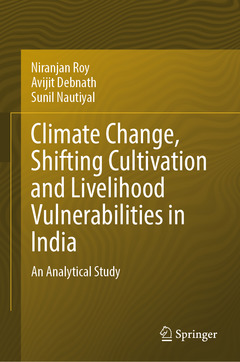Climate Change, Shifting Cultivation and Livelihood Vulnerabilities in India, 1st ed. 2024 An Analytical Study
Auteurs : Roy Niranjan, Debnath Avijit, Nautiyal Sunil

?This book explores how climate change affects households that rely on shifting cultivation and how to assess their vulnerability. This study looks at micro and macro levels in Indian states with indigenous communities practicing shifting cultivation. The micro-level study has been conducted in 52 villages, with 1469 households covering 7067 population in seven states of India in the Northeastern region. The book covers different topics related to climate change, such as its patterns, impact on households and agriculture, forest management, and the role of indigenous knowledge in mitigation. This research is associated with different sectors like shifting agriculture, forestry sector, climate change and rural development etc. and integrated with large respondents and stakeholders through both direct and focus group discussions. Research scholars, climate activists, institutional and non-institutional organisations, people interested in environmental science, social science and policymakers will find this book very relevant.
Chapter 1: Introduction.- Chapter 2: Review of Literature.- Chapter 3: An Overview on Northeastern States.- Chapter 4: Shifting Cultivation, Land Use Land Cover and Soil Erosion in North Eastern States.- Chapter 5: Socio Economic Analysis of Sample Households in Northeast India.- Chapter 6: Trend and Pattern of Weather Variables in North Eastern States of India.- Chapter 7: Household Level Livelihood Vulnerabilities in Northeastern States of India.-Chapter 8: Lessons from the Khonoma Village in India.- Chapter 9: Lessons from the State of Sikkim.- Chapter 10: Summary and Policy Suggestions.
Date de parution : 05-2024
Ouvrage de 175 p.
15.5x23.5 cm



